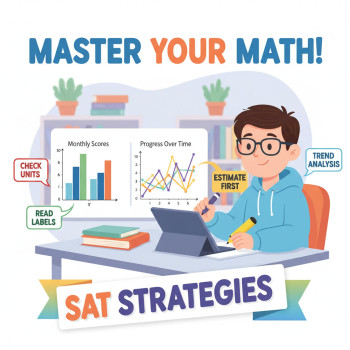The Link Between Self-Awareness and SAT Improvement
When students tell me they want to “boost my SAT score,” they usually mean one thing: more practice. That’s understandable — practice matters. But what separates a flatline of repeated tests from real, measurable progress is not just how many hours you log; it’s how well you understand yourself while you study. Self-awareness — the ability to notice your habits, weaknesses, and how you respond under pressure — is the secret multiplier of effective SAT preparation.
Why self-awareness matters more than blind repetition
Think about two students who each spend 50 hours prepping. Student A practices tests passively: they take full-length exams, glance at scores, and move on. Student B spends the same time but also tracks which question types they miss, the thinking errors behind those misses, and how fatigue affects the last 30 minutes of the test. Over time, Student B adapts strategies based on evidence. Which student will improve more? Almost always Student B. That difference is the power of self-awareness.
What we mean by self-awareness in SAT prep
Self-awareness in this context is a blend of metacognition (thinking about your thinking) and practical reflection. It includes:
- Knowing which question types consistently trip you up (e.g., data interpretation, sentence structure, algebra with functions).
- Recognizing how your energy and focus change during a timed section.
- Identifying recurring habit errors (e.g., misreading units, rushing on the last five math problems, or skipping passages).
- Understanding which study methods actually translate into learning for you — active recall, spaced repetition, teaching others, or targeted drills.
Real student snapshot: Jamie’s story
Jamie scored a 1130 after weeks of textbook drills. Frustrated, she started a simple journal: after every practice test she recorded the types of mistakes, the time when concentration dipped, and one action to try next time. Within eight weeks, guided by these reflections and focused practice, Jamie’s score climbed to 1290. The content she studied didn’t drastically change; her approach did. She shifted from blind practice to informed practice.
How to build actionable self-awareness: step-by-step
Self-awareness isn’t mystical — it’s a set of habits you can train. Here’s a pragmatic routine you can adopt:
1) Begin with a baseline and a simple log
Take a diagnostic full-length SAT under realistic conditions. Record your score and then open a notebook or digital sheet where you log for each section:
- The question types you missed (with short labels like “vocab in context” or “system of equations”).
- How many minutes you spent on those questions.
- Any emotional or physical notes: tired, rushed, bored, confident.
This first step transforms vague worries into concrete items you can address.
2) Classify errors — content, process, or careless
Every missed question usually fits into one of three buckets:
- Content gap: You don’t know a rule or concept (e.g., exponent rules, noun-verb agreement).
- Process error: You know the concept but executed the wrong strategy (e.g., you tried to calculate when plugging in numbers would be faster).
- Careless mistake: Simple slips like sign errors, misreading a question, or filling the bubbled answer incorrectly.
When you categorize errors this way, you stop treating every miss as the same problem. A content gap needs teaching and example practice. A process error needs strategy training. Careless mistakes need attention to routines and fatigue management.
3) Use short, frequent reflections
After each practice session (even a 30-minute drill), write a short reflection — one to three sentences. Ask yourself:
- What surprised me in this session?
- Which question took me way longer than it should have?
- Was I rushing or sitting too long on one problem?
These tiny reflections create a trail of micro-data you can analyze weekly.
4) Time-blocked practice and checkpoint tests
Self-aware studying uses small experiments: deliberately change one variable and see what happens. Try a week of timed sections with strict pacing, then a week focused on untimed concept mastery. Compare which week gives bigger improvements on checkpoint tests. The comparison is where insight lives.
Tools and techniques that amplify self-awareness
Below are techniques that help you turn intuition into evidence.
Error analysis template
Create a single-page template for error analysis and fill it after every practice test. A simple template includes: question number, correct answer, your answer, error category (content/process/careless), why you made the error, and an action to prevent it next time. Reviewing this template weekly reveals patterns you wouldn’t notice in isolation.
Timing heatmap
Draw a simple timeline for each practice test and mark where you spent most time or lost focus. You’ll begin to see whether your problem is early sprinting (spending too long on initial questions) or late fatigue. Small pacing adjustments — like reserving 5 minutes to scan and flag tough questions — can convert to several points.
Compare approaches, not just raw hours
Ask: did that extra hour involve active error correction or passive question-counting? Active methods (explain an answer aloud, write a short summary, or teach a peer) lead to deeper learning. Track the nature of study time as carefully as the number of minutes.
A sample 8-week self-aware study plan (table)
This table is a concise example showing how to embed reflection and targeted practice into a calendar. Adjust hours and focus areas to fit your schedule.
| Week | Focus | Hours/week | Self-awareness checkpoint | Expected score movement (approx) |
|---|---|---|---|---|
| 1 | Diagnostic test + error log setup | 6 | Baseline strengths & weaknesses | 0–10 |
| 2 | Target weakest area (content) | 8 | Content gap list & short reflections | 10–25 |
| 3 | Timing & pacing drills | 8 | Timing heatmap | 5–15 |
| 4 | Mixed practice + checkpoint test | 6 | Full review of error template | 5–20 |
| 5 | Process-focused strategies | 8 | Strategy logs (e.g., plug-in, backsolve) | 5–15 |
| 6 | Practice under fatigue (evening tests) | 7 | Energy & focus notes | 3–10 |
| 7 | Tweak routines & timed full test | 10 | Big-picture pattern review | 5–20 |
| 8 | Final polishing & test simulation | 6 | Confidence & stress management checks | 5–30 |
Note: expected score movement is an estimate; individual gains depend on starting point, quality of practice, and how honestly you track mistakes.
Mindset and emotional self-awareness
One of the most underrated parts of SAT prep is emotional awareness. Anxiety, perfectionism, or avoidance can quietly sabotage progress. Recognizing these patterns is crucial:
Common emotional traps
- Perfection paralysis: Spending too long on a single question to avoid making a mistake.
- Test avoidance: Skipping full-length practice because a single bad score feels demotivating.
- Overconfidence: Ignoring weak areas because mock tests show strength in unrelated sections.
Respond to these traps with compassionate, specific plans: if you freeze on hard questions, practice a strict “flag and return” routine until it becomes automatic. If you avoid full tests, schedule shorter timed sections first and build up tolerance.
Stress-check ritual
Before every full-length test or proctored simulation, do a two-minute ritual: breathe deeply for one minute, remind yourself of one strategy you have practiced, and scan your error log for the one common mistake to avoid. This quick ritual shifts attention from fear to actionable control.
How tutors and feedback accelerate self-awareness
Self-awareness benefits enormously from external mirrors. A skilled tutor can spot blind spots you don’t see — flawed reasoning that seems natural to you, or patterns of misinterpretation. That’s why many students pair self-guided reflection with expert feedback.
Where personalized tutoring fits naturally
Imagine you’ve been logging errors for weeks but keep misclassifying process errors as content gaps. An experienced tutor can look at your explanations and say, “You know the concept; you just need a different strategy.” That clarity turns weeks of inefficient work into targeted practice. Sparkl’s personalized tutoring offers 1-on-1 guidance, tailored study plans, expert tutors, and AI-driven insights that can help surface patterns faster and suggest precise next actions. When combined with your self-awareness routine, that feedback loop becomes a high-speed improvement cycle.
Practical exercises to strengthen self-awareness right now
Try these straightforward exercises this week:
- After each practice question, write one sentence explaining why the answer is correct. This forces metacognitive processing.
- Keep a weekly “three-pattern” note: the three most common errors you made and one specific change you will implement the next week.
- Time yourself on a small set of 10 questions and mark how confident you feel about each answer, then compare confidence to accuracy. Overconfidence and underconfidence are both useful signals.
Example: confidence vs. accuracy drill
Pick 20 Reading questions. For each one, write C, M, or H (low, medium, high confidence) before checking the answer. Later, count how often high confidence was wrong and low confidence was right. If high-confidence misses are common, your reading strategy may skip subtle traps. If low-confidence corrects are common, you might be underestimating your strengths and losing time on easier items.
Measuring progress meaningfully
Progress is not only a rising raw score. It’s also cleaner error types, improved pacing, and more consistent focus during the last 20 minutes of the test. Use these metrics to measure real improvement:
- Reduction in careless mistakes per test.
- Decrease in average time spent on similarly leveled questions.
- Fewer repeated content gaps over two-week intervals.
- Improved correlation of confidence and accuracy.
Putting it all together: a weekly routine you can follow
Here’s a compact weekly loop that combines practice, reflection, and targeted action:
- Day 1: Timed practice section + error template.
- Day 2: Focused content review on the top two error types.
- Day 3: Strategy drills (timing, backsolving, passage mapping).
- Day 4: Short mixed practice + reflection entry (three-pattern note).
- Day 5: Full-length practice or checkpoint test (alternate weeks).
- Day 6: Tutor review or peer teach session — get external feedback.
- Day 7: Rest, light review, and stress-check ritual.
Consistency matters more than intensity. Small daily evidence-gathering and weekly synthesis build self-awareness and transform study time into score gains.
Closing thoughts: small insights, big gains
When students focus on understanding themselves, everything else becomes clearer. You’ll stop guessing why you miss certain questions and start designing precise solutions. That is the difference between studying more and studying smarter. Remember: progress on the SAT is rarely a single dramatic breakthrough. It’s the accumulation of small, intentional adjustments informed by honest reflection.
If you want a partner in that process, tutoring can make your self-awareness routine far more effective. Whether you’re refining timing, fixing recurring errors, or building a personalized study plan, expert feedback accelerates insight. Sparkl’s personalized tutoring offers targeted 1-on-1 guidance, tailored study plans, expert tutors, and AI-driven insights that can complement your reflection habits and help you test the highest-impact changes faster.


Start this week with one small experiment: keep an error log after your next practice test and commit to one change for the following week based on that log. Track whether that small change helps on a checkpoint test. Repeat. After a few cycles, you’ll notice not only a higher score but a smarter, more confident test-taker.
Final pep talk
Your brain is adaptable. Self-awareness is simply the practice of giving it the right feedback loop. Be patient, be honest in your reflections, and treat mistakes as data, not judgments. The SAT is a learned skill — and with deliberate self-awareness, you can learn it faster and with more joy than endless, unfocused repetition.
Good luck, and enjoy the discovery. You’ll be surprised by how much progress a little introspection can produce.















No Comments
Leave a comment Cancel